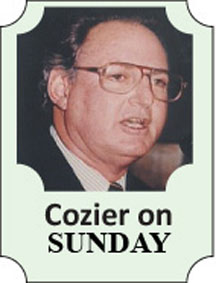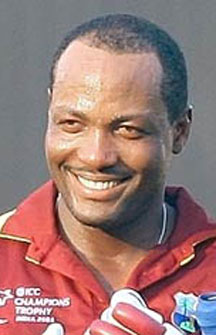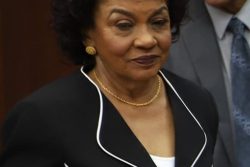There were uncanny similarities between the West Indies’ rousing victory in last Sunday’s World T20 final and that in the 2004 Champions Trophy, not least the players’ uninhibited celebrations afterwards and the impact on fans everywhere.
“The entire West Indian party roared onto the field in semi-darkness, hugging, kissing and screaming, ecstatic yet bewildered by their achievement,” Wisden wrote in describing the scenes eight years ago.
It omitted dancing (inevitably with Chris Gayle and Dwayne Bravo to the fore, if then in Caribbean rather than Gangnam style) and a little bit of weeping. It’s all there on YouTube to be enjoyed and for parallels to be drawn.
There could be no doubt what the wins, especially the manner of them, meant to the teams. Nor was there any doubt what they meant to all West Indians.
Even friends who wouldn’t know the difference between Darren Sammy and Sammy Davis junior or a leg-bye and a by-election rang to rejoice, coincidentally at almost precisely the same east Caribbean time as the win was completed in 2004.
Both matches, the former 50 overs an innings three years before the shorter version was introduced, were played on the home team’s own turf (and the latter to the backdrop of 30,000, noisy, expectant, flag-waving Sri Lankans).
In each, the West Indies were seemingly dead at one point – but they were certainly not properly buried. Through a never-say-die confidence seldom experienced over the previous three decades, they arose to achieve their miracle.
 At the Oval, in the gathering gloom of a late September’s day, they were 147 for eight needing 71 to trump England’s all-out 217. Number 9, wicket-keeper Courtney Browne, and number 10, left-arm seam bowler Ian Bradshaw, were together as their last flickering hope.
At the Oval, in the gathering gloom of a late September’s day, they were 147 for eight needing 71 to trump England’s all-out 217. Number 9, wicket-keeper Courtney Browne, and number 10, left-arm seam bowler Ian Bradshaw, were together as their last flickering hope.
At that stage, they drifted to 100-1 outsiders with English bookmakers. Whoever backed them had a fat cheque to collect when Bradshaw, an understated cricketer, slapped the winning boundary through point with all the flamboyance of his illustrious skipper, Brian Lara.
At the Premadasa, the situation was no less bleak half-way through their 20 overs. The West Indies were 32 for two and their main man, Gayle (with Dwayne Bravo, the only survivors from 2004) gone. Betting is illegal in that part of the world but 100-1 would not have been a far-fetched offering.
Marlon Samuels, who himself had been resurrected from the cricketing grave to be transformed in the past five months into one of the contemporary game’s finest batsmen, then swiftly changed the mood of the two camps and the course of the match.
His 78 off 56 balls with six breathtaking sixes and an withering assault on Lalith Malinga, often Sri Lanka’s most potent weapon, was widely rated as the finest ever in a T20 International. It stood alongside his special 123 out of 209 against New Zealand in the entirely different environment of a Test match two months earlier.
Ravi Rampaul further dented Sri Lanka’s spirit with his unplayable first ball that plucked out Tillekeratne Dilshan’s off-stump. The mystery of Sunil Narine, the control of the other bowlers and the fielding, under the direction of the often belittled captain, Sammy, ensured there was no way back for the tense hosts.
The dumfounded look on Sri Lankan captain Mahela Jayawardene’s face as defeat became ever more certain was the same as that on Michael Vaughan’s when Browne and Bradshaw turned down the umpires’ offer to leave the field in the Oval darkness, as Bradshaw put it afterwards, “to go with the momentum.”
After both successes, there were neutral appreciations of the roles of the two captains. Utterly contrasting as cricketers – Lara the genius, Sammy the journeyman – both were under fire from their demanding public as the West Indies continued to flounder. Under Lara, the West Indies had been whitewashed 4-0 by England in the Test series that preceded the Champions Trophy; Sammy’s limitations as a player have been repeatedly questioned, often bitterly.

Matthew Engel, editor of Wisden, called 2004 “a personal triumph for their captain Brian Lara, the man who had suffered most abuse during their recent decline.”
Although he scored only 14 in the final, Engel noted that “he produced an inspired performance in the field,” snaring three catches and a run out and hardly missing a trick in bowling changes and field placings.
This is what the Trinidad Express editorial had to say about Sammy: “Whatever our reservations about his captaincy, captain Sammy deserves our admiration and congratulations for keeping his team united, committed and inspired enough to survive early defeat against Sri Lanka and come back to take the trophy against them. Yesterday’s triumph can only have enhanced confidence in Sammy’s captaincy.” In the final, his 15-ball, unbeaten 26 and two wickets were telling contributions.
“I think this is the impetus we need to move forward,” Lara commented after his team’s achievement. Sammy’s sentiments were similar last Sunday.
Now, once the euphoria subsides, there are lessons to be learnt by the West Indies Cricket Board (WICB), as well as the West Indies Players Association (WIPA), from what transpired to ruin Lara’s optimism.
Immediately afterwards, the WICB replaced Gus Logie, the former West Indies player, as coach with the first foreigner in the position, the Australian Bennett King.
Within two months, most of those invited to prepare for an ODI triangular series in Australia the following February declined to sign the proposed tour contracts.
The WIPA accused the WICB of “an attempt to exploit the players for commercial purposes.” It took the intervention of then Grenada prime minister Keith Mitchell and arbitration to allow the chosen team to go (sound familiar?). In Australia, they won one of their six matches.
By March, another dispute over sponsorship contracts led to Lara’s resignation as captain; by July, less than a year after Lara lifted the Champions Trophy, a makeshift team had to be hurriedly assembled and sent to Sri Lanka for a series of three Tests because of a strike by the leading players.

It ended after the disagreeing organizations sought the intervention of the International Cricket Council (ICC) and the International Federation of Cricketers Associations (FICA).
As it happens, the WICB and the WIPA are soon before a judge again.
The outcome of arbitration on the future of their Memorandum of Understanding (MoM) and the Collective Bargaining Agreement (CBA) is expected to be announced this week. This is to be followed by the WIPA’s US$20 million restraint of trade lawsuit on behalf of it members against the WICB.
The two organizations have new chief executives who have both spoken encouragingly about their desire to foster less confrontational relations with each other. They will need to tread carefully in the coming months to ensure there is no repeat of 2004.
As has been clear for too long, West Indies cricket can only thrive when the administrators and the players are on the same wavelength.
Given the history, it might seem impossible – but so did the comebacks at the Oval and at the Premadasa.




